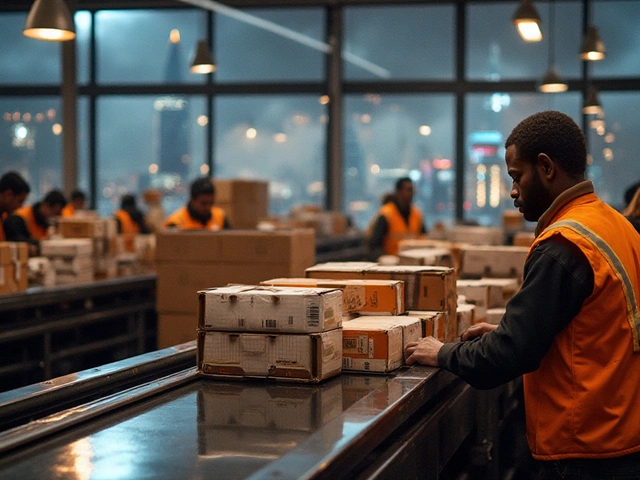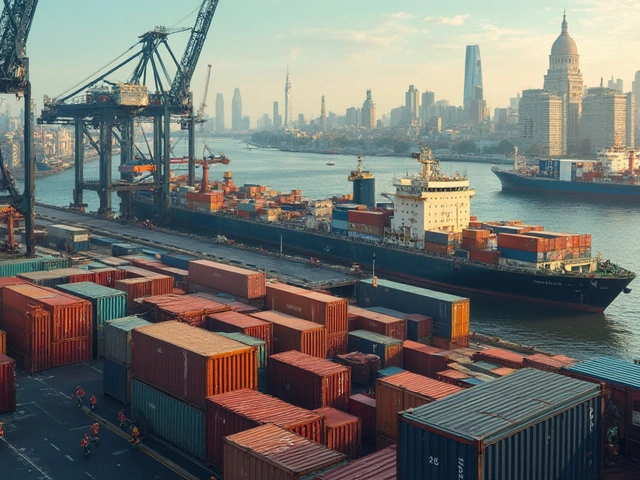Who actually has the best international shipping rates? If you've ever filled your cart and then almost fainted at the shipping cost, you're not alone. Prices can swing wildly between carriers like UPS, FedEx, DHL, and even national post offices. And here's the kicker—rates change constantly, sneaky fees can pop up, and not every carrier lists the real total upfront.
The differences aren't just nickels and dimes. Shipping a basic 5-pound box from the US to Europe can cost anywhere from $50 to over $150, depending on who you pick and how fast you want your item to travel. Some carriers look cheap at first glance, but once you factor in fuel surcharges, remote area delivery, or customs paperwork, your bargain deal vanishes.
To score the best rate, you can't just glance at the first price you see. Real savings come from comparing actual quotes using the right details—box size, weight, exact destination, and urgency. Still, there's more to it. Some carriers offer handy rate calculators online, but not all factor in additional charges, like package pickup or Saturday delivery. Knowing where to look, and what questions to ask, can make or break your budget.
- Comparing the Major Shipping Carriers
- Hidden Costs and Surprising Fees
- Tips for Getting Lower International Rates
- When to Use Niche or Regional Couriers
Comparing the Major Shipping Carriers
When it comes to international shipping, the big-name carriers—FedEx, UPS, DHL, and national post offices like USPS—dominate the choices. But each has its own pricing tricks, speed, and coverage. So, who usually offers the best deal?
FedEx and UPS are everywhere. They’re reliable and fast, but they can also be pricey for individual packages, especially if you need speedy delivery. For most people shipping a small box (under 10lbs) to Europe or Asia, rates start around $70-$80 for basic economy service. Need it there overnight? That’ll easily jump to $200 or more.
DHL is the specialist in global deliveries. They're super popular for shipping to Europe and parts of Asia, often beating FedEx and UPS on pricing and delivery times for certain routes. A lot of international e-commerce stores use DHL since they're a bit more flexible with customs and have solid package tracking. Rough estimate: A 5lb package to London can range from $65 to $110, depending on speed and extras.
Don’t sleep on your national postal service, like USPS for Americans or Royal Mail in the UK. Their global services (like USPS Priority Mail International) are usually the cheapest for smaller, less urgent packages. The caveat? Tracking might not be as detailed, and delays can happen with customs. Still, you can send a 5lb box to most countries for as low as $55, though delivery might take a week or longer.
Here’s a real peek at June 2024 price ranges for a 5lb (2.3kg) box shipped from New York to London:
| Carrier | Economy Rate | Express Rate |
|---|---|---|
| FedEx | $78 | $198 |
| UPS | $84 | $210 |
| DHL | $68 | $185 |
| USPS | $54 | Not available |
If you’re shipping heavier stuff (think 20lbs or more), commercial carriers (like FedEx or DHL) can actually become cheaper per pound since their bulk rates kick in. And if you’re running a business, getting a contract or joining shipping programs can shave off 10-40% from standard rates, no joke.
Hot tip: Always check each carrier’s website for shipping calculators. Some, like DHL, even show all-in estimates including customs paperwork and handling fees. Never trust a single online quote—play around with package size, weight, and speed to uncover sneaky cost changes.
Hidden Costs and Surprising Fees
You found a cheap international shipping quote, but then—boom—your bill is loaded with extras. This is super common thanks to all those little fees carriers tack on. If you're not careful, your final cost can be double what you expected. It's not just about the main rate; you have to watch the details.
Here are some of the most common extra charges you’ll see with major shipping carriers:
- Fuel surcharges: These change monthly and can add 10-20% (sometimes more) to your bill, especially for fast express services.
- Remote area delivery: Sending a package to rural Australia or a village in Greece? Both DHL and FedEx can charge $20-$40 extra for anything they call a 'remote' address.
- Address correction: If you mess up the street address—just a tiny typo—FedEx, UPS, and DHL charge $15-$20 just to fix it.
- Customs clearance fees: You’ll always pay for customs paperwork, even with basic services. UPS, for example, often adds a brokerage fee on shipments to Canada as high as $35.
- Duties and taxes: Not technically a carrier fee, but still hits your wallet hard. Some carriers require you to pay these up front; others surprise the receiver on the other end.
- Package pickup and delivery surcharges: Home pickups or deliveries to apartment blocks? That can mean extra fees, especially from FedEx and UPS.
Just how big are these surprise costs? Check out this real-world sample:
| Fee Type | FedEx | DHL | UPS |
|---|---|---|---|
| Fuel Surcharge (5lb package, EU) | $14.50 | $13.80 | $14.60 |
| Remote Area Delivery | $34.00 | $35.00 | $41.00 |
| Address Correction | $19.50 | $16.00 | $20.00 |
If you’re shipping something valuable, try using each carrier's shipping calculator, but add in the likely surcharges manually based on your destination and package details. Reading each carrier’s surcharge list before buying is annoying but saves you big-time regrets down the road.

Tips for Getting Lower International Rates
Shaving down your international shipping bill is totally doable once you know where carriers sneak in fees and how to play their systems to your advantage. The first golden rule: don’t just stick with the big names. Many folks automatically go for FedEx, DHL, or UPS, but sometimes national post offices like USPS or even Canada Post offer deals that beat the big guys, especially for lightweight packages.
Check out what’s actually making your package expensive. Carriers base rates not just on weight, but also on size—so a small, heavy box may cost less than a big, empty one. If you can shrink your packaging even a little, you’ll save. FedEx and DHL both use dimensional weight on international shipments, so measure carefully and avoid unnecessary padding.
- Compare rates using live calculators. FedEx, UPS, DHL, and most national posts have online calculators. Plug in your dimensions, weight, and destination. Always compare at least three carriers.
- Ship in bulk when possible. One box with several items often costs less per item than sending lots of smaller boxes. Carriers even have bulk discounts for business accounts.
- Negotiate rates for frequent shipping. If you're sending packages often—even as a small business—reach out to a carrier rep. A lot of people don’t know you can get better rates just by asking. Some companies, especially DHL and UPS, have special rates for e-commerce stores or regular shippers.
- Timing matters. Avoid expedited delivery unless absolutely necessary. Standard or economy shipping saves big, and many times, the actual delivery time doesn’t differ much. If it’s not urgent, choose the slower service.
- Skip the extras. Saturday delivery, early-morning drop-offs, and package pickups all cost extra fees. If you can drop your package at a carrier location, you’ll usually save a few bucks.
- Watch out for remote surcharges. Delivering to out-of-the-way places often triggers extra fees. You can check your address on carrier websites for any surprises before paying.
To make the differences more obvious, here’s a quick snapshot of what shipping a 5-pound, medium box from New York to London can look like for 2025:
| Carrier | Service | Quoted Rate (USD) |
|---|---|---|
| FedEx | International Economy | $85 |
| DHL | Express Worldwide | $95 |
| UPS | Worldwide Saver | $90 |
| USPS | Priority Mail International | $70 |
As you can see, choosing the right service and carrier makes a real difference. The gap between USPS and DHL here is $25—enough for an extra lunch or two. Compare, use calculators, and don’t be afraid to ask for a deal. That’s how you get the best shipping rates without cutting corners on reliability.
When to Use Niche or Regional Couriers
Most folks default to the big names—FedEx, DHL, and the rest—when they think of international shipping. But if you’re tired of outrageous rates or need to ship somewhere off the usual path, niche or regional couriers can often save you a ton.
Regional options like Aramex (for the Middle East), SF Express (for China and Southeast Asia), or Correios (for Brazil) cater specifically to their regions, which often means lower prices and better local service. These carriers understand customs hurdles, common delivery issues, and local laws way better than the global giants. For example, Aramex is a go-to for shipping into and out of the UAE, often charging 20-30% less than US-based couriers. Meanwhile, SF Express is known for cheap, fast delivery inside China, especially for e-commerce sellers targeting Asian markets.
Here's when you should check out a regional or niche courier:
- Your packages are headed to harder-to-reach countries. Think Africa, South America, or rural parts of Asia—big carriers can get pricey or just slow.
- You're shipping sensitive items. Some regional players specialize in temperature-controlled shipments or have expertise in electronics, food, or medical products that require extra care.
- Cost is your #1 concern. For bulk or heavy shipments, regional carriers sometimes offer better deals, especially if the item starts and ends its journey in their network.
You should also consider their experience with customs. For example, Correios knows the exact paperwork that smooths out the Brazilian customs process, which is legendary for slowing down international shipping from unfamiliar carriers. Working with a courier who understands the local scene cuts down on surprise fees and delays.
| Carrier | Main Region | Average Rate (5kg, to Europe) |
|---|---|---|
| Aramex | Middle East | $70 |
| SF Express | China, SE Asia | $52 |
| FedEx | Global | $130 |
One quick tip: Many regional carriers also work with online consolidators or freight forwarders. These platforms, like Easyship or Shippo, show hidden carrier options and compare prices in real-time, letting you spot a crazy-good deal from a name you might have never considered.





